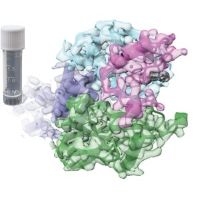Specification
| Organism | Homo sapiens (Human) |
| Expression Host | E.coli |
| Tag Info | N-terminal GST-tagged |
| Purity | Greater than 85% by SDS-PAGE |
| Uniprot ID | O14818 |
| Gene Names | PSMA7 |
| Alternative Names | Proteasome subunit R;C6-1;Proteasome subunit XAPC7 |
| Expression Region | Partial(5-232aa ) |
| Molecular Weight | 52.4 kDa |
| Protein Sequence | RAITVFSPDGHLFQVEYAQEAVKKGSTAVGVRGRDIVVLGVEKKSVAKLQDERTVRKICALDDNVCMAFAGLTADARIVINRARVECQSHRLTVEDPVTVEYITRYIASLKQRYTQSNGRRPFGISALIVGFDFDGTPRLYQTDPSGTYHAWKANAIGRGAKSVREFLEKNYTDEAIETDDLTIKLVIKALLEVVQSGGKNIELAVMRRDQSLKILNPEEIEKYVAEI |
| Form | Liquid or Lyophilization |
| Buffer | The default storage buffer is Tris/PBS-based buffer, 5%-50% glycerol if the delivery form is liquid. The lyophilization buffer is Tris/PBS-based buffer, 6% Trehalose, pH 8.0 if the delivery form is lyophilized powder. Please contact us if you have any special requirment. |
| Reconstitution | Please reconstitute protein in deionized sterile water and we recommend that briefly centrifuge thevial prior to opening the vial .We recommend aliquot for long-term storage at -20℃/-80℃. |
Background
| Relevance | The proteasome is a multicatalytic proteinase complex which is characterized by its ability to cleave peptides with Arg, Phe, Tyr, Leu, and Glu adjacent to the leaving group at neutral or slightly basic pH. The proteasome has an ATP-dependent proteolytic activity. Plays an important role in the regulation of cell proliferation or cell cycle control, transcriptional regulation, immune and stress response, cell differentiation, and apoptosis. Interacts with some important proteins involved in transcription factor regulation, cell cycle transition, viral replication and even tumor initiation and progression. Inhibits the transactivation function of HIF-1A under both normoxic and hypoxia-mimicking conditions. The interaction with AP2 increases the proteasome-mediated HIF-1A degradation under the hypoxic conditions. Plays a role in hepatitis C virus internal ribosome entry site-mediated translation. Mediates nuclear translocation of the androgen receptor (AR) and thereby enhances androgen-mediated transactivation. Promotes MAVS degradation and thereby negatively regulates MAVS-mediated innate immune response. |
| Involvement in Disease | |
| Subcellular Location | Cytoplasm, Nucleus |
| Protein Families | Peptidase T1A family |
| Tissue Specificity | PSMA7 |
QC Data
| Note | Please contact us for QC Data |
| Product Image (Reference Only) |  |

